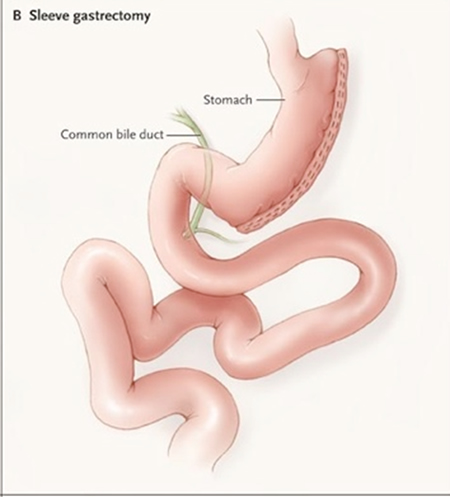The Laparoscopic Gastric Sleeve
How it works:
The gastric sleeve is a restrictive procedure only. Unlike a roux-en-y gastric bypass or the duodenal switch, there is no bypass of the small intestines with the gastric sleeve, so all nutrients are absorbed. Other names for gastric sleeve resection are sleeve gastrectomy, vertical sleeve gastrectomy, tube gastrectomy and laparoscopic sleeve gastrectomy. During this procedure the surgeon removes about 60 percent of the stomach so that it takes the shape of a tube or sleeve. (See figure). Unlike gastric banding surgeries, no foreign objects are left in the body during the procedure. A gastric bypass often follows or duodenal switch after the patient has lost a significant amount of weight. This is called a “staged” approach to weight loss.

What to Expect After Gastric Sleeve Surgery
Patients will need to become re-used to eating solid foods. Normally this starts with two weeks on a liquid-only diet, two weeks of semi-solid, pureed foods and then solids.
Studies have shown that after the gastric sleeve resection procedure people show improvement in diabetes, high blood pressure, high cholesterol and sleep apnea within one to two years. These improvements are comparable with those seen after other weight loss surgeries.
Certain lifestyle changes and follow-up care occur afterward; people who have gastric sleeve surgery must:
- Exercise regularly.
- Learn behavior modification techniques.
- Follow very specific dietary instructions, including eating very slowly, consuming only small quantities of food at a time, chewing thoroughly and swallowing food only when it is mashed, and not eating and drinking at the same time.
Risks and complications include:
- Leaking of the sleeve. The operation requires staples to be inserted into the stomach, and there is always a chance that the staples will tear apart, resulting in a leak. The leaking stomach acids frequently become infected and can cause serious problems that may require another operation or a drainage tube.
- Blood clots
- Weight may be regained over time, because the stomach can stretch.
- Unlike gastric banding surgeries, no foreign objects are left in the body during the procedure. With gastric banding, the band may slip, erode or become infected.
- Unlike gastric bypass or duodenal switch, there is no bypass of the small intestines with the gastric sleeve, so all nutrients are absorbed and very little chance exists of absorption issues.
- Wound infection
Long Term Results:
As far as weight loss goes, most people who have gastric sleeve surgery lose 30 to 50 percent of their excess body weight over six months to one year. As this is a relatively new procedure, no data is available yet on long-term weight loss or overall health improvements.
Relevant Articles Published by Dr. Frantzides on this Procedure
Minimally Invasive Sleeve Gastrectomy; In Atlas of Minimally Invasive Surgery. Frantzides, Carlson,(eds.) Elsevier 2008.
Want to Know More About Dr. Frantzides? See what others are saying: www.ObesityHelp.com
